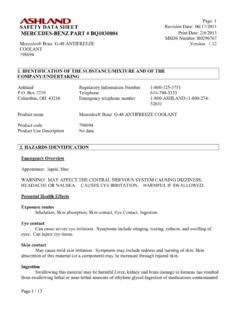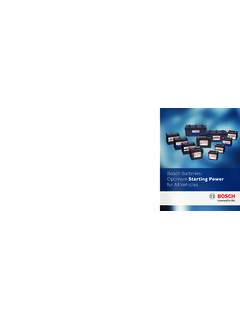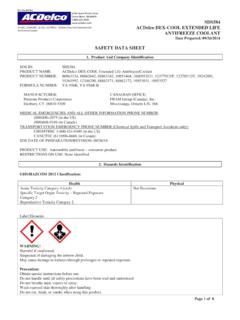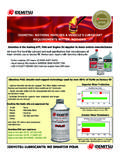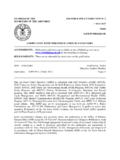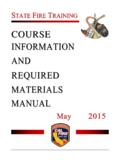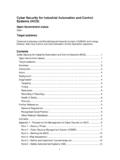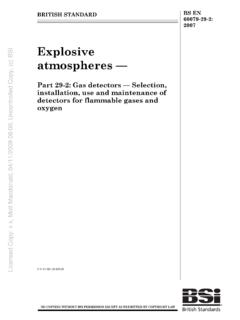Transcription of JOHNSEN'S NON-CHLORINATED BRAKE PARTS …
1 JOHNSEN'S NON-CHLORINATED BRAKE PARTS cleaner 14 OZ. safety Data Sheet according to Federal Register / Vol. 77, No. 58 / Monday, March 26, 2012 / Rules and Regulations Revision date: 05/19/2015 : Version: 09/07/2015 EN (English US) 1/14 SECTION 1: Identification of the substance/mixture and of the company/undertaking Product identifier Product form : Mixture Trade name : JOHNSEN'S NON-CHLORINATED BRAKE PARTS cleaner 14 OZ. Product code : 2413 Relevant identified uses of the substance or mixture and uses advised against Use of the substance/mixture : BRAKE PARTS cleaner Details of the supplier of the safety data sheet Technical Chemical Company BOX 139 Cleburne, Texas 76033 T 817-645-6088 Emergency telephone number Emergency number : CHEMTREC 24 Hour 1-800-424-9300, 1-703-527-3887 (International) SECTION 2: Hazards identification Classification of the substance or mixture Classification (GHS-US) Flam.
2 Aerosol 2 H223 Compressed gas H280 Acute Tox. 3 (Oral) H301 Acute Tox. 3 (Dermal) H311 Skin Irrit. 2 H315 Eye Irrit. 2A H319 Repr. 2 H361 STOT SE 1 H370 STOT SE 3 H336 STOT RE 2 H373 Full text of H-phrases: see section 16 Label elements GHS-US labeling Hazard pictograms (GHS-US) : GHS02 GHS04 GHS06 GHS07 GHS08 Signal word (GHS-US) : Danger Hazard statements (GHS-US) : H223 - Flammable aerosol H280 - Contains gas under pressure; may explode if heated H301+H311 - Toxic if swallowed or in contact with skin H315 - Causes skin irritation H319 - Causes serious eye irritation H336 - May cause drowsiness or dizziness H361 - Suspected of damaging fertility or the unborn child H370 - Causes damage to organs H373 - May cause damage to organs through prolonged or repeated exposure Precautionary statements (GHS-US) : P201 - Obtain special instructions P202 - Do not handle until all safety precautions have been read and understood P210 - Keep away from heat,sparks,open flames,hot surfaces.
3 - No smoking P211 - Do not spray on an open flame or other ignition source P251 - Pressurized container: Do not pierce or burn, even after use P260 - Do not breathe dust,fumes,gas,mist,vapor spray P261 - Avoid breathing dust,fume,gas,mist,vapor spray P264 - Wash affected areas thoroughly after handling P270 - Do not eat, drink or smoke when using this product P271 - Use only outdoors or in a well-ventilated area P280 - Wear protective gloves,protective clothing,eye protection,face protection P301+P310 - If swallowed: Immediately call a poison control center, doctor,physician, P302+P352 - If on skin: Wash with plenty of soap and water P304+P340 - If inhaled: Remove person to fresh air and keep comfortable for breathing JOHNSEN'S NON-CHLORINATED BRAKE PARTS cleaner 14 OZ. safety Data Sheet according to Federal Register / Vol.
4 77, No. 58 / Monday, March 26, 2012 / Rules and Regulations 09/07/2015 EN (English US) 2/14 P305+P351+P338 - If in eyes: Rinse cautiously with water for several minutes. Remove contact lenses, if present and easy to do. Continue rinsing P307+P311 - If exposed: Call a poison center/doctor P308+P313 - If exposed or concerned: Get medical advice/attention P312 - Call a POISON CONTROL CENTER, doctor, if you feel unwell. P314 - Get medical advice/attention if you feel unwell P321 - Specific treatment: See section on SDS P330 - Rinse mouth P332+P313 - If skin irritation occurs: Get medical advice/attention P337+P313 - If eye irritation persists: Get medical advice/attention P361 - Take off immediately all contaminated clothing P362 - Take off contaminated clothing and wash it before reuse P363 - Wash contaminated clothing before reuse P403+P233 - Store in a well-ventilated place.
5 Keep container tightly closed P405 - Store locked up P410+P403 - Protect from sunlight. Store in a well-ventilated place P410+P412 - Protect from sunlight. Do not expose to temperatures exceeding 50 C/122 F P501 - Dispose of contents/container to appropriate waste disposal facility, in accordance with local, regional, national, international regulations. Other hazards Other hazards not contributing to the classification : Contains gas under pressure; may explode if heated. Unknown acute toxicity (GHS US) No data available SECTION 3: Composition/information on ingredients Substance Not applicable Mixture Name Product identifier % Classification (GHS-US) Methanol (CAS No) 67-56-1 20-40 Flam. Liq. 2, H225 Acute Tox. 3 (Oral), H301 Acute Tox. 3 (Dermal), H311 Acute Tox. 3 (Inhalation:dust,mist), H331 STOT SE 1, H370 Acetone (CAS No) 67-64-1 10 - 30 Flam.
6 Liq. 2, H225 Eye Irrit. 2A, H319 STOT SE 3, H336 Toluene (CAS No) 108-88-3 10 - 30 Flam. Liq. 2, H225 Skin Irrit. 2, H315 Repr. 2, H361 STOT SE 3, H336 STOT RE 2, H373 Asp. Tox. 1, H304 Heptane, Branched Cyclic (CAS No) 426260-76-6 - Flam. Liq. 1, H224 Skin Irrit. 2, H315 STOT SE 3, H336 Asp. Tox. 1, H304 Aquatic Chronic 3, H412 n-Heptane (CAS No) 142-82-5 - Flam. Liq. 2, H225 Skin Irrit. 2, H315 STOT SE 3, H336 Asp. Tox. 1, H304 Aquatic Acute 1, H400 Aquatic Chronic 1, H410 Carbon Dioxide, Liquefied, Under Pressure (CAS No) 124-38-9 5 - 10 Compressed gas, H280 The exact percentage is a trade secret. SECTION 4: First aid measures Description of first aid measures First-aid measures general : Never give anything by mouth to an unconscious person. IF exposed or concerned: Get medical advice/attention.
7 Call a POISON CENTER or doctor/physician. First-aid measures after inhalation : Cough. Remove victim to fresh air and keep at rest in a position comfortable for breathing. Call a POISON CENTER or doctor/physician if you feel unwell. First-aid measures after skin contact : Rinse skin with water/shower. Immediately call a poison center or doctor/physician. Remove/Take off immediately all contaminated clothing. Wash with plenty of soap and water. Wash contaminated clothing before reuse. If skin irritation occurs: Get medical advice/attention. First-aid measures after eye contact : Remove contact lenses, if present and easy to do. Continue rinsing. Rinse cautiously with water for several minutes. Immediately call a poison center or doctor/physician. Obtain medical attention if pain, blinking or redness persist.
8 Direct contact with the eyes is likely to be irritating. First-aid measures after ingestion : Rinse mouth. Do NOT induce vomiting. Obtain emergency medical attention. Immediately call a poison center or doctor/physician. JOHNSEN'S NON-CHLORINATED BRAKE PARTS cleaner 14 OZ. safety Data Sheet according to Federal Register / Vol. 77, No. 58 / Monday, March 26, 2012 / Rules and Regulations 09/07/2015 EN (English US) 3/14 Most important symptoms and effects, both acute and delayed Symptoms/injuries : Suspected of damaging fertility or the unborn child. Causes damage to organs. Symptoms/injuries after inhalation : May cause respiratory irritation. Shortness of breath. May cause drowsiness or dizziness. Symptoms/injuries after skin contact : Repeated exposure to this material can result in absorption through skin causing significant health hazard.
9 Toxic in contact with skin. Causes skin irritation. Symptoms/injuries after eye contact : Irritation of the eye tissue. Inflammation/damage of the eye tissue. Redness of the eye tissue. Symptoms/injuries after ingestion : Toxic if swallowed. Swallowing a small quantity of this material will result in serious health hazard. Indication of any immediate medical attention and special treatment needed No additional information available SECTION 5: Firefighting measures Extinguishing media Suitable extinguishing media : Foam. Dry powder. Carbon dioxide. Water spray. Sand. Unsuitable extinguishing media : Do not use a heavy water stream. Special hazards arising from the substance or mixture Fire hazard : Flammable aerosol. Explosion hazard : Heat may build pressure, rupturing closed containers, spreading fire and increasing risk of burns and injuries.
10 Advice for firefighters Firefighting instructions : Use water spray or fog for cooling exposed containers. Exercise caution when fighting any chemical fire. Prevent fire-fighting water from entering environment. DO NOT fight fire when fire reaches explosives. Evacuate area. Protection during firefighting : Do not enter fire area without proper protective equipment, including respiratory protection. Other information : Aerosol Level 2. SECTION 6: Accidental release measures Personal precautions, protective equipment and emergency procedures General measures : No open flames. No smoking. Isolate from fire, if possible, without unnecessary risk. Remove ignition sources. Use special care to avoid static electric charges. For non-emergency personnel Protective equipment : safety glasses.



